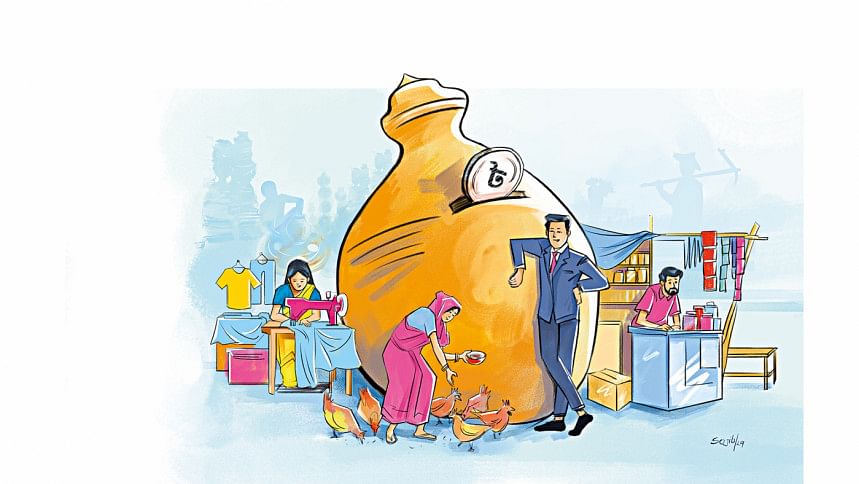Leveraging the power of SMEs

Small and Medium Enterprises (SMEs) are vital to the economic development of countries, particularly in developing nations like Bangladesh. This sector is considered the financial backbone due to the large number of entrepreneurs it produces. Renowned for its labour-intensive nature and short gestation period, the SME sector significantly boosts national income and generates rapid employment opportunities.
According to Dr. Mohammad Masudur Rahman, Chairperson of the SME Foundation, SMEs currently contribute 30-32% to the GDP, but there is potential for them to contribute even more significantly to overall economic development.
With a vision to create a vibrant SME sector in the country, the government first formulated the SME policy in 2015 under the Ministry of Industries, building on the previous SME Strategy Framework of 2005.
"In the past decade, significant efforts have been made to foster the SME sector, including the establishment of the SME Foundation. Policymakers now recognise the crucial role of SMEs in driving overall national development, leading to substantial policy-level support for the sector," says Dr. Mohammad Masudur Rahman. However, he also acknowledges that Bangladesh lags behind its neighbouring states in terms of SME contribution to GDP. For instance, SMEs account for 60% of India's GDP, over 70% in China, and approximately 50-60% in Vietnam.
Although over 24 million people are employed in this sector, SMEs' contribution to GDP isn't increasing sufficiently, which could hinder the country's financial growth despite support from banks and financial institutions. "Due to inflation and economic hardship, there is currently a lack of enthusiasm for expanding this sector. Entrepreneurs are focused on survival rather than adding new features, as production costs have risen while sales have fallen due to price increases. Since the end of last year, we've observed that it has been a slow period for SMEs," shares Syed Abdul Momen, Deputy Managing Director and Head of SME Banking at BRAC Bank, the most SME-focused bank in the country.
According to the last Economic Census conducted by the Bangladesh Bureau of Statistics in 2013, there were 7.88 million SMEs in the country. Experts now estimate that there are over 10 million SMEs in Bangladesh, highlighting the steady growth of the SME sector in Bangladesh.
Banks and financial institutions have played a crucial role in fostering the growth of SMEs. They support the integration of SMEs into formal economic channels. In the absence of these formal channels, SME entrepreneurs often turn to informal sources such as NGOs or local moneylenders, who charge exorbitant interest rates. This reliance on informal borrowing perpetuates a vicious cycle of debt, hindering any significant improvement in their economic fortunes.
Importantly, Bangladesh Bank introduced several schemes and programmes to flourish and expand SMEs. In 2004, the central bank introduced a refinancing scheme named the "Small Enterprise Refinance Scheme" with an initial fund of BDT 1.0 billion to support the development of small enterprises. To meet the increasing demand from end borrowers, the fund has undergone multiple augmentations and currently stands at BDT 30.0 billion after the latest increase.

Following the guidance from the central bank, banks and NBFIs, for the first time, established an indicative target for SME loan disbursement in 2010. "Around one and a half decades ago, banks and NBFIs would show little interest in SME finance. Now, they perceive financing SMEs as secure, with minimal risk of bad loans compared to other sectors. Currently, SMEs constitute a significant portion of their portfolio, contributing substantially to their profits from SME lending," notes Dr. Mohammad Masudur Rahman.
The recent two-year pandemic has been devastating for the entire SME sector. In response to mitigating the adverse effects of COVID-19 and reviving economic activities, the Government of Bangladesh announced a financial stimulus package of BDT 200 billion in 2020 for the CMSME. This initiative aimed to increase the flow of credit and investment in the sector within the country. Subsequently, on April 26, 2020, a revolving refinance scheme amounting to BDT 100 billion was introduced from Bangladesh Bank's own source through SMESPD. Under this scheme, participating banks and financial institutions (PFIs) are availing refinance facilities up to 50 percent of their lending. Bank insiders believe these incentives have been crucial for the SME sector to endure the challenges of the pandemic and to rejuvenate in the post-pandemic period with renewed spirit.
Bangladesh Bank has mandated that all banks allocate 25 percent of their total loan disbursement to CSMEs by December 2024, and banks are diligently adhering to this directive.
According to the Bangladesh Bank's Quarterly Statement of SME Loan Disbursement for October-December 2023, the total outstanding loans and advances amount to BDT 1,591,852.20 crore. Of this, Non-Bank Financial Institutions (NBFIs) account for BDT 56,049.48 crore, while scheduled banks total BDT 1,535,802.72 crore.
Banks and financial institutions are increasingly aligning with government directives to support and enhance the SME sector, which is experiencing gradual growth.
"Midland Bank is very positive about SMEs. We are actively campaigning for them and will be opening an SME centre within two weeks—one in Nababpur and one in Gazipur. We have received permission from the central bank, and we are regularly disbursing loans and receiving repayments," shares Md Ahsan Jamil Hossain, Head of SME and Agri at Midland Bank.
Although over 24 million people are employed in this sector, SMEs' contribution to GDP isn't increasing sufficiently, which could hinder the country's financial growth despite the support from banks and financial institutions.
"City Bank entered the SME sector 6-7 years ago, and we now have a portfolio of around BDT 4,500 crore in this sector. We are extensively distributing loans through our vast network of branches, sub-branches, and agent banking. More than 78 percent of our loans go to rural and semi-metropolitan areas," shares Kamrul Mehedi, Head of SME at City Bank.
He further states that if banks invest more in networking for SMEs it would significantly enhance financial inclusion. SMEs would be able to obtain loans from formal channels at much lower interest rates compared to local NGOs or money lenders.
"We have observed that loan repayment in this sector is very promising. Even when occasional defaults occur, they can repay their loans with minimal incentives if they have good intentions. At BRAC Bank, the non-performing loan (NPL) rate for collateral-free loans is only 2.5 percent, whereas the NPL rate in the corporate sector is about 6-7 percent," says Syed Abdul Momen, Deputy Managing Director and Head of SME Banking at BRAC Bank.
However, there is still a demand-supply gap in terms of SME loan distribution.
Currently, only 36 percent of the required loans for SMEs are obtained from formal economic channels, while the remainder comes from the informal sector, according to Dr. Mohammad Masudur Rahman, Chairperson of the SME Foundation. He emphasises that bringing more SMEs into the formal sector would be mutually beneficial for both SMEs and banks or NBFIs.
"About 20% of total loans and advances of the banking sector is given to CMSMEs of the country. We are lagging in meeting the expected target of the Central Bank. The demand-supply gap is visible, and there is a large stake out of reach of formal lenders. Almost all lenders are trying to expedite and scale up lending activities in SMEs," says Md. Khalid Mahmood Khan, Additional Managing Director & CBO of Mutual Trust Bank.
Most banks or financial institutions don't have organic links with SMEs, unlike many local NGOs or a few SME-focused banks. As a result, banks can't fully commit to loan disbursement for SMEs. However, some procedural changes could be a game changer, making these loans more accessible to SMEs.
"Formal economic channels often have rigid criteria that many CMSMEs cannot meet, especially cottage and micro-level businesses. To address this, financial institutions need to develop more flexible and innovative financing solutions, reduce bureaucratic hurdles, and improve the reach of financial services to underserved areas," notes Md. Mahbubur Rahman Palash, Executive Vice President and Head of MSME and Emerging Business Division, Dhaka Bank.
Banks and financial institutions are increasingly aligning with government directives to support and enhance the SME sector, which is experiencing gradual growth.
"With the introduction of NID cards and a national database, we now have access to potential lenders' addresses. If we make it clear that failure to repay loans will result in being marked as defaulters, and if this record is considered when applying for other government and private services, the process of receiving SME loans would become much easier," shares Shaminoor Rahman, Head of SME at Bank Asia.
"SMEs require monitoring and close supervision; otherwise, they could derail or become traceless. We not only provide loans but also act as consultants for their business. Since monitoring costs are high, we need to focus on digitalising the entire process and transactions to reduce these costs," mentions Md Kamruzzaman Khan, Executive Vice President and Head of SME Financial Services at Lankabangla Finance.
"Enhancing offers such as risk-sharing financing, flexible credit guarantee schemes, and more refinance options can increase banks' willingness to finance CMSMEs, attracting formal financiers and improving their accessibility to formal financial channels. Formal financial institutions can also reduce operational costs by creating diversified product suites and using digital solutions, boosting CMSME financing and promoting significant sector growth," states Ebnul Alam Palash, Head of MSME Business, Prime Bank.

 For all latest news, follow The Daily Star's Google News channel.
For all latest news, follow The Daily Star's Google News channel. 



Comments